
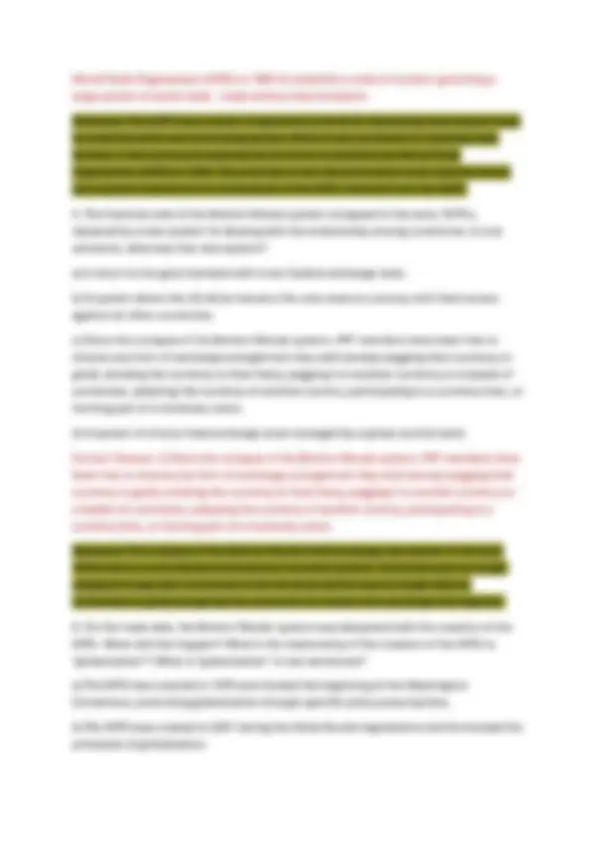
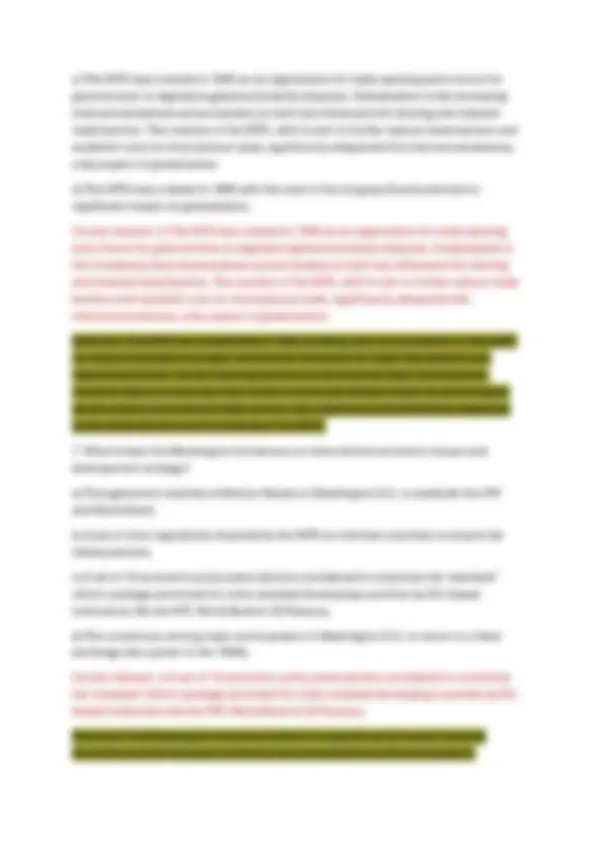
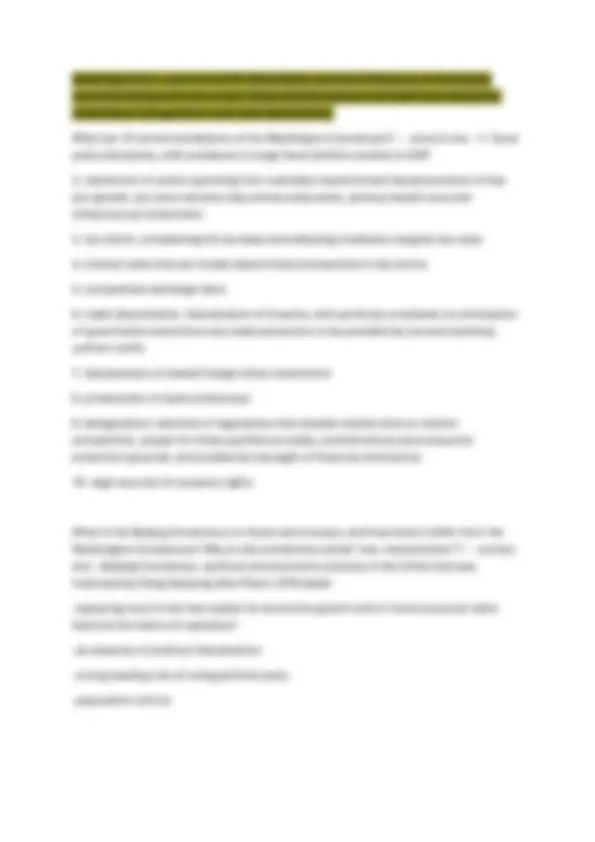
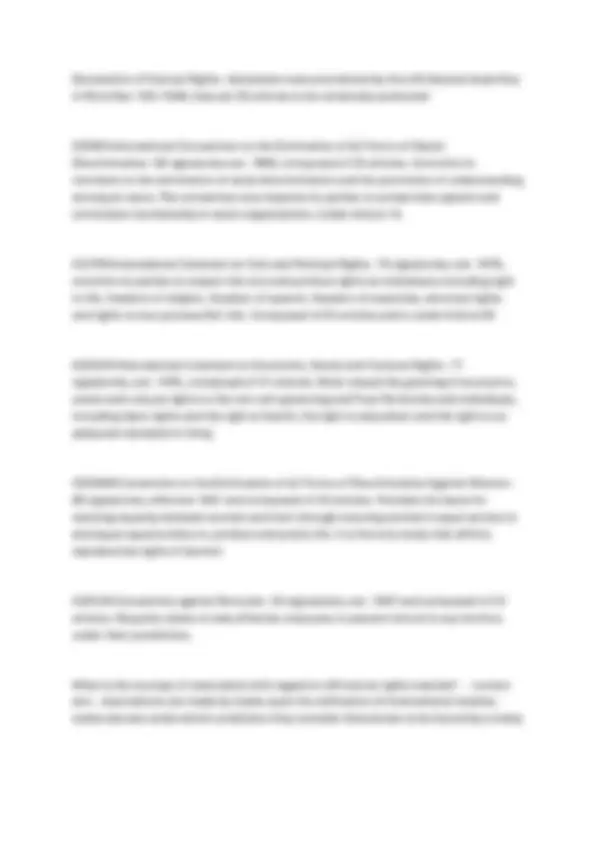
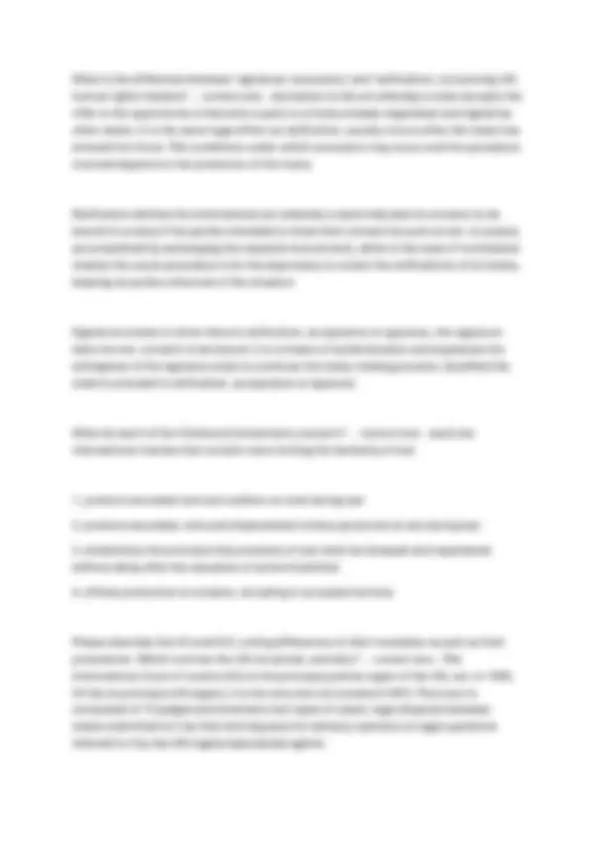
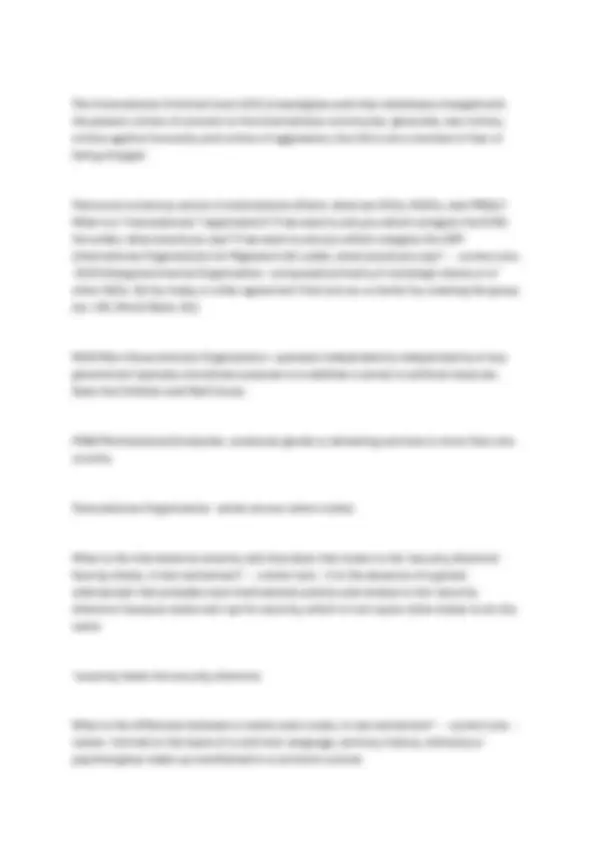
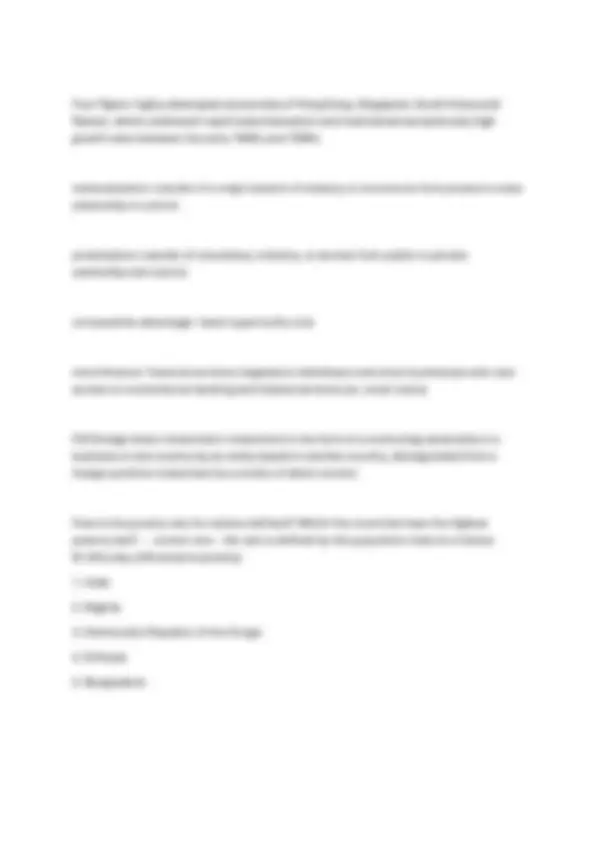
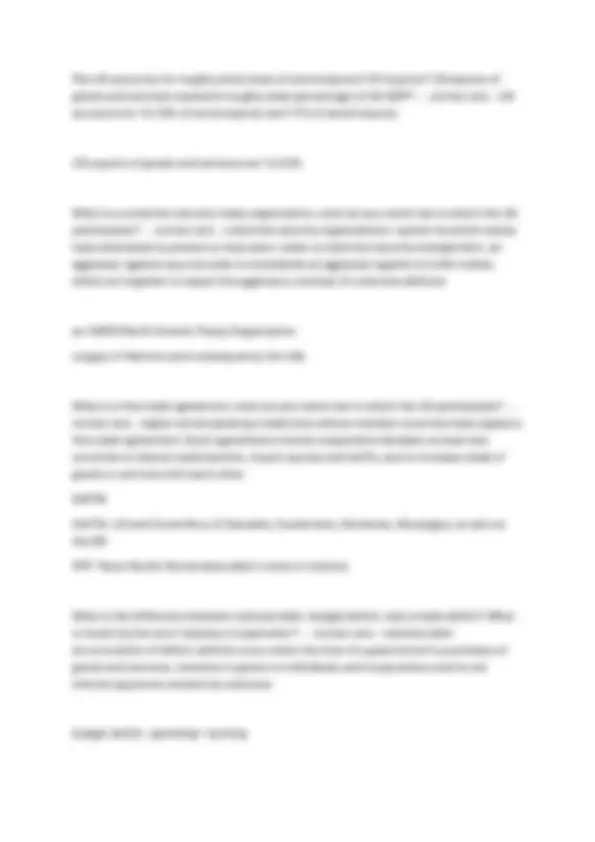
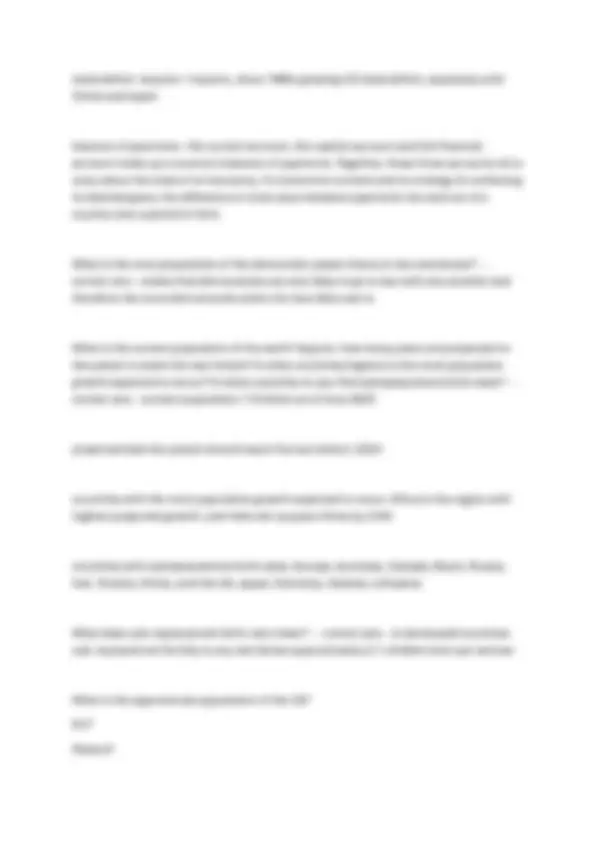
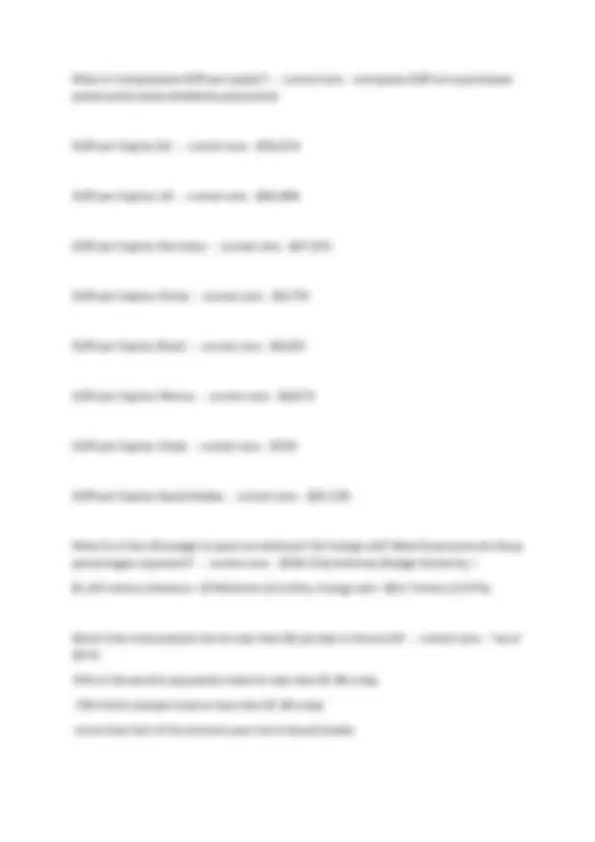
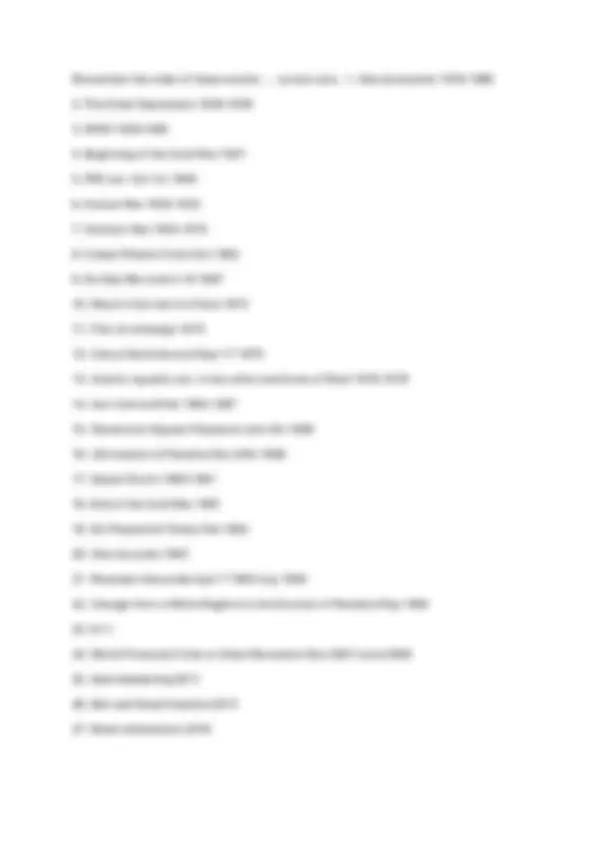
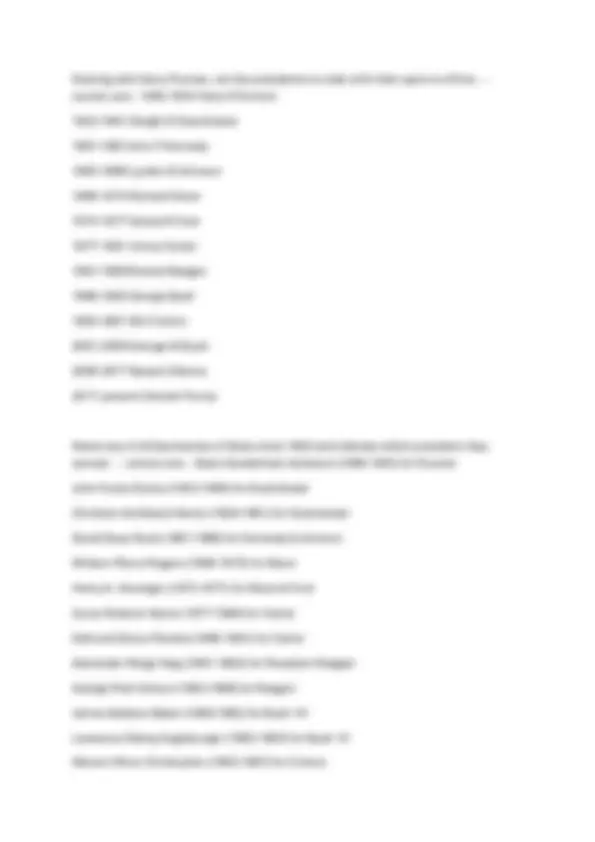
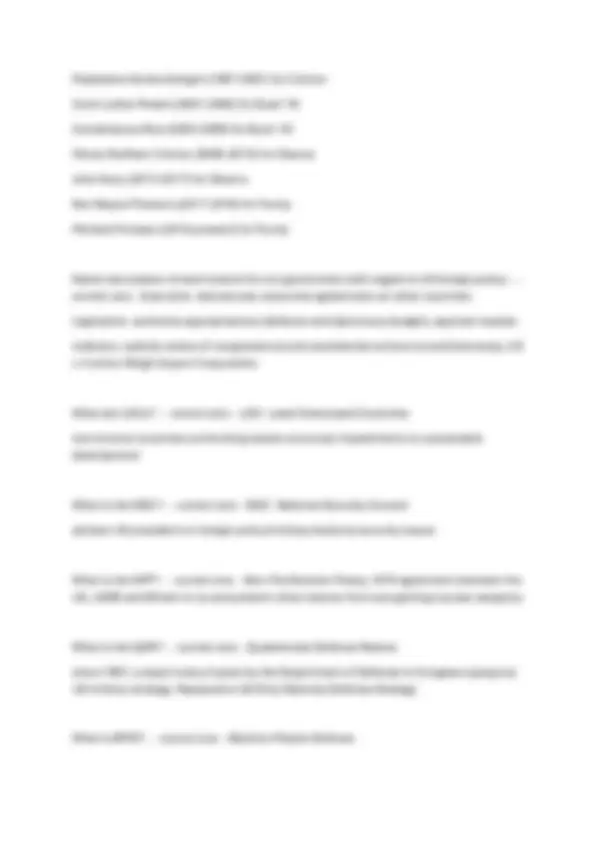
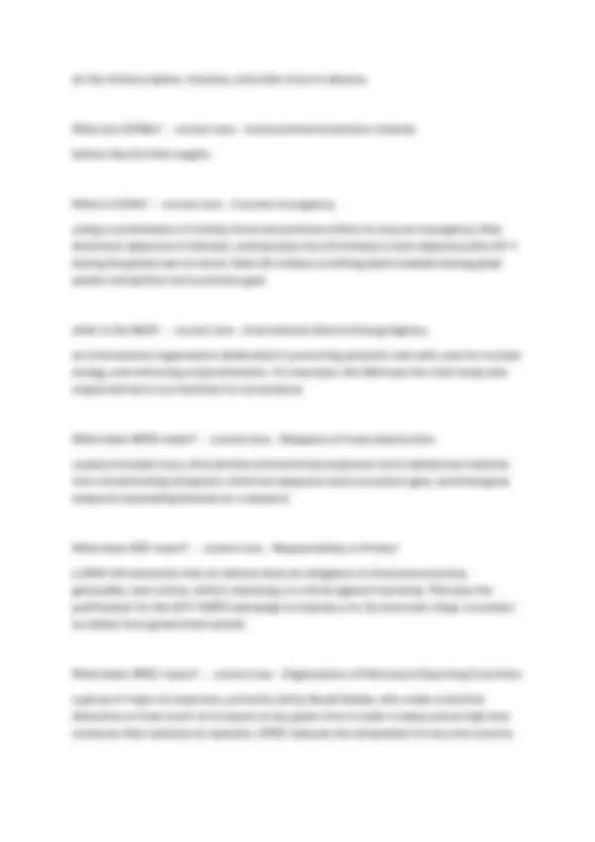
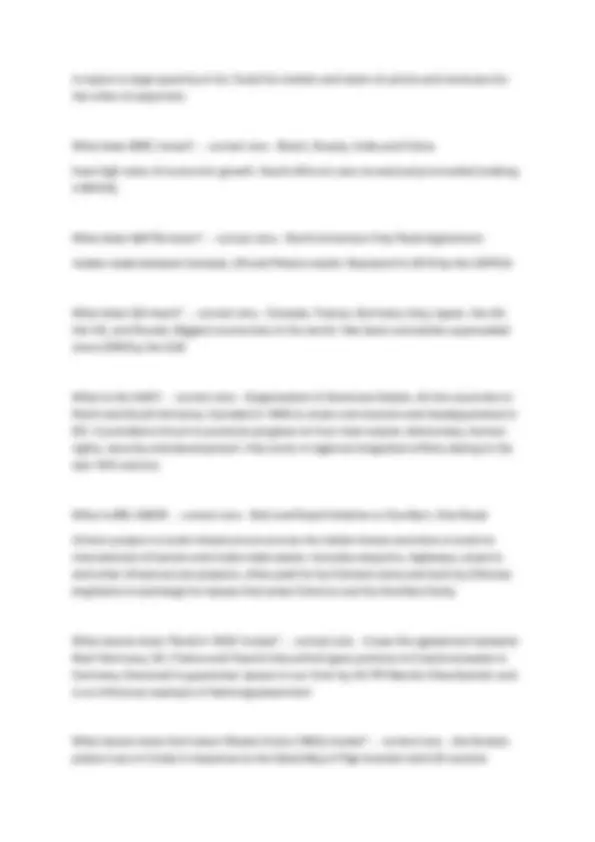
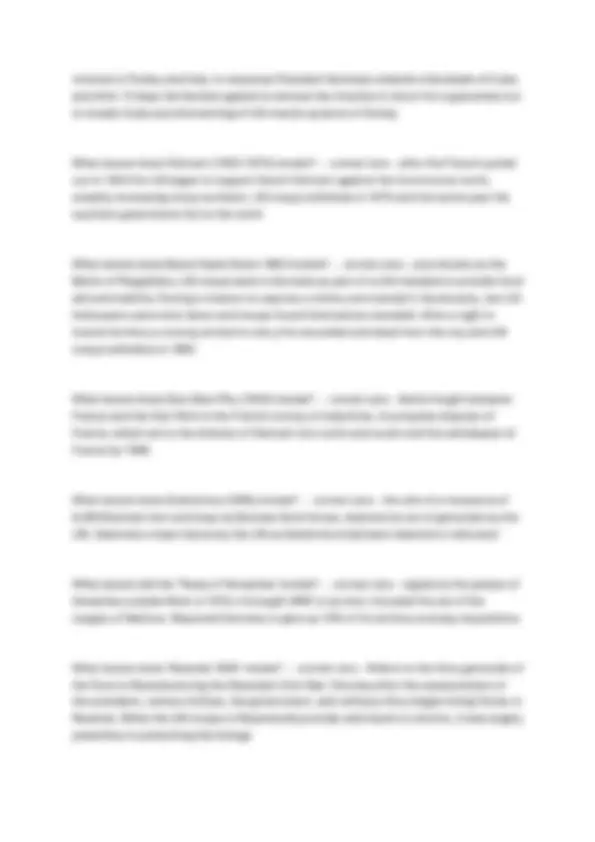
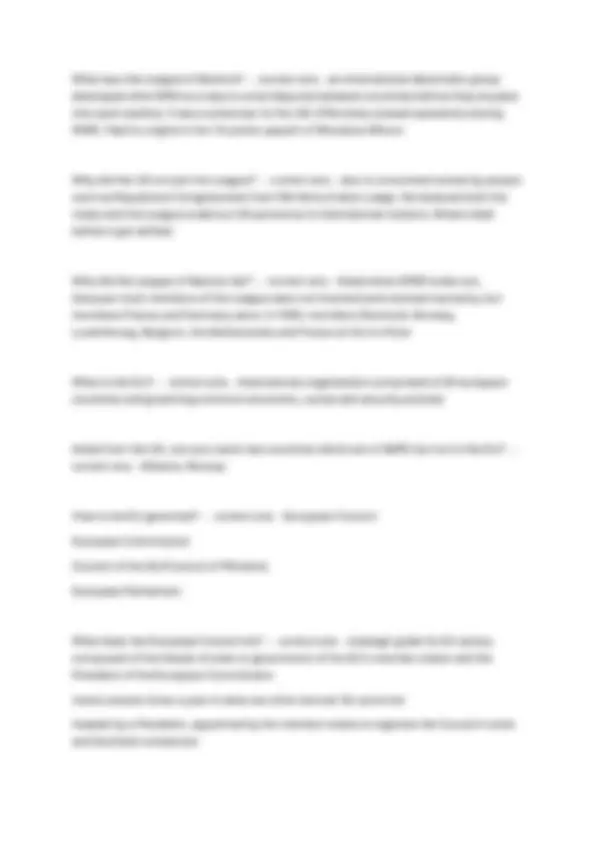
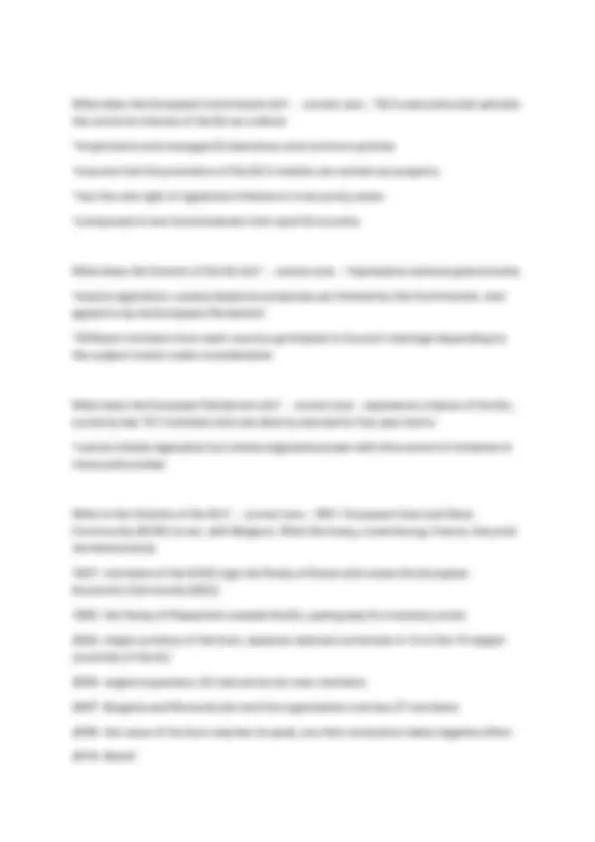
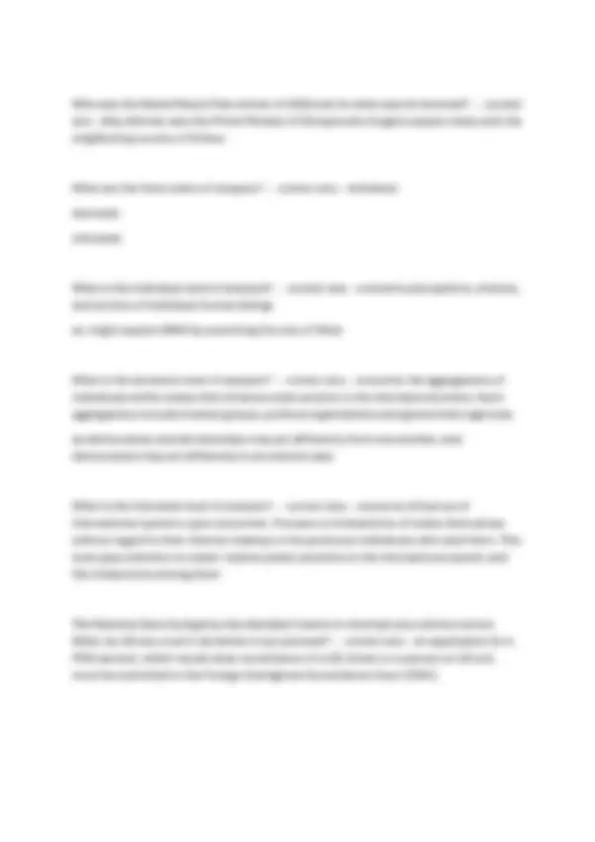


Study with the several resources on Docsity

Earn points by helping other students or get them with a premium plan


Prepare for your exams
Study with the several resources on Docsity

Earn points to download
Earn points by helping other students or get them with a premium plan
Community
Ask the community for help and clear up your study doubts
Discover the best universities in your country according to Docsity users
Free resources
Download our free guides on studying techniques, anxiety management strategies, and thesis advice from Docsity tutors
Bush School Entrance Exam 2025: Comprehensive Study Guide with Practice Tests, Application Tips, and Expert Strategies for Top Admission Results
Typology: Exams
1 / 27

This page cannot be seen from the preview
Don't miss anything!




















Correct Answer: c) An organization of 188 countries to foster monetary cooperation, secure financial stability, facilitate trade, and promote sustainable economic growth; it manages exchange rates and international payments. Rationale: The International Monetary Fund (IMF) is indeed an organization with a broad mandate encompassing monetary cooperation, financial stability, trade facilitation, and sustainable economic growth. A key function is the management of exchange rates and the system of international payments to ensure smooth financial transactions between countries.
c) The WTO was created in 1995 as an organization for trade opening and a forum for governments to negotiate agreements/settle disputes. Globalization is the increasing interconnectedness across borders as tech has enhanced info sharing and lowered trade barriers. The creation of the WTO, with its aim to further reduce trade barriers and establish rules for international trade, significantly deepened this interconnectedness, a key aspect of globalization. d) The WTO was created in 1986 with the start of the Uruguay Round and had no significant impact on globalization. Correct Answer: c) The WTO was created in 1995 as an organization for trade opening and a forum for governments to negotiate agreements/settle disputes. Globalization is the increasing interconnectedness across borders as tech has enhanced info sharing and lowered trade barriers. The creation of the WTO, with its aim to further reduce trade barriers and establish rules for international trade, significantly deepened this interconnectedness, a key aspect of globalization. Rationale: The WTO was established in 1995, building upon the foundation of the GATT. Its creation provided a stronger institutional framework for trade liberalization and dispute settlement, further reducing barriers to international trade. Globalization, characterized by increasing cross-border interconnectedness driven by technological advancements and reduced trade barriers, was significantly facilitated and deepened by the establishment and functioning of the WTO.
Washington D.C., such as the IMF, World Bank, and the US Treasury, to developing countries facing economic crises. These policies typically included fiscal discipline, privatization, deregulation, and trade liberalization. What are 10 recommendations of the Washington Consensus? - - correct ans- - 1. fiscal policy discipline, with avoidance to large fiscal deficits relative to GDP
Security Council = UNSC: primary responsibility for the maintenance of international peace and security. Has 15 members and each has one vote; 5 permanent members are China, France, Russia, the UK and US; 10 non-permanents are elected for two-year terms by the General Assembly. All member states are obligated to comply with council decisions Economic and Social Council (ECOSOC): works to advance the three dimensions of sustainable development; economic, social and environmental. Responsible for the follow-up to major UN conferences and summits International Court of Justice- role is to settle legal disputes submitted by states, and give advisory opinions on legal questions referred to it by authorized UN organs. Composed of 15 judges who are elected by 9 years by the General Assembly and Security Council Secretariat- organized along departmental lines, with each department or office having a distinct area of action and responsibility; sitting Secretary General is António Guterres of Portugal What are some UN sub-organizations? - - correct ans- - World Health Organization (WHO): direction/coordinating authority on international health UN Human Rights Council (UNHCR): an inter-governmental body within the UN system made of 47 states responsible for the promotion and protection of all human rights around the globe UNICEF: works in over 190 countries and territories to save children's lives/defend their rights/help them fulfill potential There are numerous human rights treaties that have promulgated under the UN system, starting with the Universal Declaration of Human Rights, and including treaties/covenants on civil and political rights, economic and social rights. Describe the primary issue area of the 9 major human rights treaties. - - correct ans- - Universal
Declaration of Human Rights- declaration was proclaimed by the UN General Assembly in Paris Dec 10th 1948; they are 30 articles to be universally protected ICERD/International Convention on the Elimination of All Forms of Racial Discrimination- 88 signatories est. 1969, composed of 25 articles. Commits its members to the elimination of racial discrimination and the promotion of understanding among all races. The convention also requires its parties to outlaw hate speech and criminalize membership in racist organizations. Under Article 14. ICCPR/International Covenant on Civil and Political Rights- 74 signatories, est. 1976, commits its parties to respect the civil and political rights as individuals including right to life, freedom of religion, freedom of speech, freedom of assembly, electoral rights and rights to due process/fair trial. Composed of 53 articles and is under Article 49 ICESCR/International Covenant on Economic, Social and Cultural Rights- 71 signatories, est. 1976, composed of 31 articles. Work toward the granting of economic, social and cultural rights to the non-self-governing and Trust Territories and individuals, including labor rights and the right to health, the right to education and the right to an adequate standard of living CEDAW/Convention on the Elimination of all Forms of Discrimination Against Women- 99 signatories; effective 1981 and composed of 30 articles. Provides the basis for realizing equality between women and men through ensuring women's equal access to and equal opportunities in, political and public life. It is the only treaty that affirms reproductive rights of women CAT/UN Convention against Terrorism- 83 signatories, est. 1987 and composed of 33 articles. Requires states to take effective measures to prevent torture in any territory under their jurisdiction, What is the concept of reservation with regard to UN human rights treaties? - - correct ans- - reservations are made by states upon the ratification of international treaties; states declare under which conditions they consider themselves to be bound by a treaty
The International Criminal Court (ICC) investigates and tries individuals charged with the gravest crimes of concern to the international community: genocide, war crimes, crimes against humanity and crimes of aggression; the US is not a member in fear of being charged There are numerous actors in international affairs: what are IGOs, NGOs, and MNEs? What is a "transnational" organization? If we were to ask you which category the ICRC fell under, what would you say? If we were to ask you which category the IOM (International Organization for Migration) fell under, what would you say? - - correct ans-
state- a political organization within a given territory, maintains a monopoly on the use of force What is the difference between separatism and irredentism? Can you name at least two conflicts that would fall under each category? - - correct ans- - separatism- the advocacy or practice of separation of a certain group of people from a larger body on the basis of ethnicity, religion or gender (Catalonia, Quebec) irredentism- political or popular movement process by which a part of an existing state breaks away and merges with another (Taiwan on the part of China and Kashmir on the part of India/Pakistan) What do the terms power, sovereignty, national interest, and hegemony mean? - - correct ans- - power- means by which a state or other actor wields or can assert actual or potential influence or coercion relative to other states and non state actors because of the political, geographic, economic, technological, military, social, cultural, or other capabilities it possesses; can come in forms of hard, soft and smart sovereignty- full right and power of a governing body over itself, without any interference from outside sources or bodies national interest- what a nation feels to be necessary to its security and well being, reflecting the general and continuing ends for which a nation acts hegemony- political, economic or military predominance or control of one state over others What does balance of power mean, and how does it relate to conflict? - - correct ans- - can be seen as the perpetrator of conflict because the theory states that states will fight to secure their survival be trying to quash the power of others; cycle of conflict driven by balance of power
Four Tigers: highly developed economies of Hong Kong, Singapore, South Korea and Taiwan, which underwent rapid industrialization and maintained exceptionally high growth rates between the early 1960s and 1990s nationalization: transfer of a major branch of industry or commerce from private to state ownership or control privatization: transfer of a business, industry, or service from public to private ownership and control comparative advantage: lower opportunity cost microfinance: financial services targeted at individuals and small businesses who lack access to conventional banking and related services (ex. small loans) FDI/foreign direct investment: investment in the form of a controlling ownership in a business in one country by an entity based in another country, distinguished from a foreign portfolio investment by a notion of direct control How is the poverty rate for nations defined? Which five countries have the highest poverty rate? - - correct ans- - the rate is defined by the population lived at or below $1.90 a day (UN extreme poverty)
The US accounts for roughly what share of world exports? Of imports? US exports of goods and services represent roughly what percentage of US GDP? - - correct ans- - US accounts for 10.33% of world exports and 17% of world imports US exports of goods and services are 12.22% What is a collective security treaty organization, and can you name two in which the US participates? - - correct ans- - collective security organizations- system by which states have attempted to prevent or stop wars; under a collective security arrangement, an aggressor against any one state is considered an aggressor against all other states, which act together to repeal the aggressor; concept of collective defence ex: NATO/North Atlantic Treaty Organization League of Nations (and subsequently the UN) What is a free trade agreement, and can you name two in which the US participates? - - correct ans- - region encompassing a trade bloc whose member countries have signed a free trade agreement. Such agreements involve cooperation between at least two countries to reduce trade barriers, import quotas and tariffs, and to increase trade of goods or services with each other NAFTA CAFTA- US and Costa Rica, El Salvador, Guatemala, Honduras, Nicaragua, as well as the DR TPP- Trans Pacific Partnership (didn't come to fruition) What is the difference between national debt, budget deficit, and a trade deficit? What is meant by the term 'balance of payments'? - - correct ans- - national debt- accumulation of deficit, deficits occur when the total of a government's purchases of goods and services, transfers in grants to individuals and corporations and its net interest payments exceed tax revenues budget deficit- spending > earning
Russia? China? Japan? Canada? Nigeria? India? Brazil? Germany? - - correct ans- - 1. China = 1.4 billion
Germany? China? Brazil? Mexico? Chad? Saudi Arabia? What percentage of world nominal GDP does each country represent? - - correct ans- - world nominal GDP for year listed below: $85.9 Trillion nominal GDP of China - $13.6 million, percentage of world nominal GDP represented 15.8% of world nominal GDP nominal GDP of the US - $20.5 million, percentage of world nominal GDP represented 23.9% of world nominal GDP nominal GDP of the EU - $15.9 million, percentage of world nominal GDP represented 18.5% of world nominal GDP nominal GDP of Brazil - $1.88 million, percentage of world nominal GDP represented 2.19% of world nominal GDP nominal GDP of Germany - $3.9 million, percentage of world nominal GDP represented 4.59% of world nominal GDP nominal GDP of Mexico $1.2 million, percentage of world nominal GDP represented 1.42% of world nominal GDP nominal GDP of Saudi Arabia $786,521, percentage of world nominal GDP represented 0.915% of world nominal GDP nominal GDP of Chad $11,273, percentage of world nominal GDP represented 0.0131% of world nominal GDP GDP What is GDP and how is it measured? - - correct ans- - GDP = Consumption +Investment +Government Spending +(Exports-Imports) measures total value of final goods and services of a country
Starting with Harry Truman, list the presidents in order with their years in office: - - correct ans- - 1945 - 1953 Harry S Truman 1953 - 1961 Dwight D Eisenhower 1961 - 1963 John F Kennedy 1963 - 1969 Lyndon B Johnson 1969 - 1974 Richard Nixon 1974 - 1977 Gerald R Ford 1977 - 1981 Jimmy Carter 1981 - 1989 Ronald Reagan 1989 - 1993 George Bush 1993 - 2001 Bill Clinton 2001 - 2009 George W Bush 2009 - 2017 Barack Obama 2017 - present Donald Trump Name any 5 US Secretaries of State since 1950 and indicate which president they served: - - correct ans- - Dean Gooderham Acheson (1949-1953) for Truman John Foster Dulles (1953-1959) for Eisenhower Christian Archibald Herter (1959-1961) for Eisenhower David Dean Rusk (1961-1969) for Kennedy & Johnson William Pierce Rogers (1969-1973) for Nixon Henry A. Kissinger (1973-1977) for Nixon & Ford Cyrus Roberts Vance (1977-1980) for Carter Edmund Sixtus Muskie (1980-1981) for Carter Alexander Meigs Haig (1981-1982) for President Reagan George Pratt Schulz (1982-1989) for Reagan James Addison Baker (1989-1992) for Bush ' Lawrence Sidney Eagleburger (1992-1993) for Bush ' Warren Minor Christopher (1993-1997) for Clinton